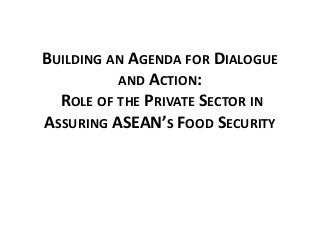
Role of the private sector in assuring ASEAN's food security: Building an agenda for dialogue and action
- 1. BUILDING AN AGENDA FOR DIALOGUE AND ACTION: ROLE OF THE PRIVATE SECTOR IN ASSURING ASEAN’S FOOD SECURITY
- 2. Background The ASEAN Secretariat in collaboration with USAID has conducted series of related public private consultations over roughly the past year •The Role of Private Sector on June 2010 in Singapore, •Sustainable Fisheries for Food Security: Fish for People in Bangkok 2011, • Improving Access, Advancing Food Security on July 2011 in Manila, and •the food security conference on Role of the Private Sector in Assuring ASEAN’s Food Security: Building an Agenda for Dialogue and Action held on 3-5 October 2011 in Jakarta.
- 3. General Themes Food security should be viewed as a farm-to-fork (value chain) issue. Stakeholders have individual perspectives, but they also have more common than divergent views. Stakeholders mostly agree on the need for harmonization of regulations, standards, notifications, registrations, and inspections in order to improve efficiency. Stakeholders expressed a need for agricultural sector diagnostics to benchmark agricultural sector practices at the farm and post-farm levels across the ASEAN Member States. Finally, public sector interaction with private sector businesses, including farmers, was uniformly seen as the primary requirement for rapid progress toward fair trade
- 4. From the Jakarta Conference: •Harmonization of regulatory requirements and standards to enable increased productivity and to facilitate trade based on scientific, international standards, including: •Maximum Residue Limits (MRLs) •Quarantine •Biotechnology safety assessments •Transparent published standards/testing requirements and procedures •Reduction of barriers to trade and non-border trade issues, including: •Low Level Presence (LLP) •Sanitary & Phytosanitary (SPS) •Harmonization of Customs documentation among ASEAN countries •Investment facilitation to reduce: •Barriers to foreign ownership/local equity requirements •Retroactive laws to ownership
- 5. Pubic-Private Dialogue -- A formal mechanism for regular public-private sector engagement. An ASEAN Food Security Dialogue (AFSD) would help stimulate: •The evolution of appropriate policy solutions; •The creation of a system to facilitate food security for the long term ; •Investment in the technology and infrastructure to enhance agricultural productivity; •The creation of economic opportunities for ASEAN farmers, food and agribusinesses; •Greater collaboration between public and private sectors
- 6. Areas for immediate work: •A Food System Approach. ASE. A piecemeal approach will not achieve the desired goals of food security and price reliability. •End Export Restrictions. •Harmonization of food standards for ASEAN. •Investment and adoption of agriculture research & development advances. •Non-border Trade Barriers. Avoidable food and agricultural trade impediments. (negotiation and collaboration to remove avoidable food trade impediments from sanitary and phytosanitary standards or the lack of mutual recognition of standards that can be shown to have comparable safety benefits. )
